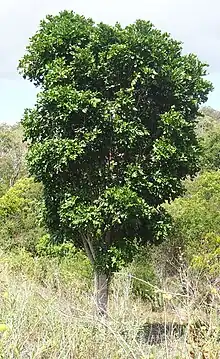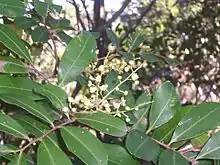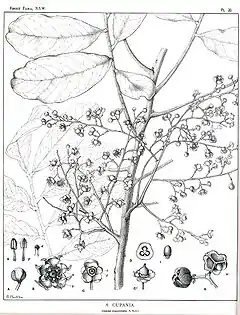Cupaniopsis anacardioides
Cupaniopsis anacardioides, with common names tuckeroo, carrotwood, beach tamarind and green-leaved tamarind, is a species of flowering tree in the soapberry family, Sapindaceae, that is native to eastern and northern Australia. The usual habitat is littoral rainforest on sand or near estuaries.[3] The range of natural distribution is from Seven Mile Beach, New South Wales (34.8° S) to Queensland, northern Australia and New Guinea.[4][5]
| Tuckeroo | |
|---|---|
 | |
| Cupaniopsis anacardioides | |
| Scientific classification | |
| Kingdom: | Plantae |
| Clade: | Tracheophytes |
| Clade: | Angiosperms |
| Clade: | Eudicots |
| Clade: | Rosids |
| Order: | Sapindales |
| Family: | Sapindaceae |
| Genus: | Cupaniopsis |
| Species: | C. anacardioides |
| Binomial name | |
| Cupaniopsis anacardioides | |
 | |
| Occurrence data from AVH | |
| Synonyms | |
|
Cupania anacardioides A.Rich. | |
Cupaniopsis anacardioides is an invasive species in some parts of the United States, primarily Florida and Hawaii.[6][7]
Description
Growing up to 10 metres (33 ft) with a stem diameter of 50 centimetres (20 in). The bark is smooth grey or brown with raised horizontal lines. The bases of the trees are usually flanged.[4][5]
Leaves are pinnate and alternate with six to ten leaflets. These are not toothed, and are egg-shaped to elliptic-oblong, and 7 to 10 centimetres (2.8 to 3.9 in) long. The tips are often notched or blunt. Leaf veins are evident on both sides. The veins are mostly raised underneath.[4][5]
Greenish white flowers form on panicles from May to July. The fruit is an orange to yellow capsule with three lobes. There is a glossy dark brown seed inside each lobe. The seeds are covered in a bright orange aril. Fruit ripens from October to December, attracting many birds including Australasian figbird, olive-backed oriole and pied currawong.[4][5]
Germination from fresh seed occurs without difficulty, particularly if the seed is removed from the aril and soaked for a few days.[4][5]


Uses
It is an attractive plant as an ornamental or a street tree, particularly in coastal areas as it is salt tolerant.[8]

References
- "APNI Cupaniopsis anacardioides". Australian Plant Name Index. Retrieved 2008-07-16.
- Radlkofer, L.A.T. (1879) Ueber Cupania und damit verwandte pflanzen. Sitzungsberichte der Mathematisch-Physikalischen Classe der Königlichen Bayerischen Akademie der Wissenschaften zu Munchen 4: 512, 530, 585
- "PCA Alien Plant Working Group - Carrotwood (Cupaniopsis anacardioides)". www.invasive.org. Retrieved 27 January 2023.
- Harden, Gwen J. (1991). "Cupaniopsis anacardioides". PlantNET - NSW Flora Online. Retrieved 2018-07-19.
- Floyd, A. G. (2008). Rainforest Trees of Mainland South-eastern Australia (2nd, Revised ed.). Lismore, New South Wales: Terania Rainforest Publishing. p. 385. ISBN 978-0-958943-67-3. Retrieved 2009-06-18.
- "Cupaniopsis anacardioides as a weed in Florida". University of Florida. Retrieved 2009-08-03.
- "Sapindaceae Fruits and Seeds". USDA Agricultural Research Service. Retrieved 2018-07-16.
- Langeland, K.A.; Enloe, S.F. (2015). "EDIS SS-AGR-165: Natural Area Weeds Carrotwood (Cupaniopsis anacardioides)". University of Florida. Retrieved 2018-07-16.
External links
- "Cupaniopsis anacardioides". PlantNET - NSW Flora Online. Retrieved 2009-08-03.